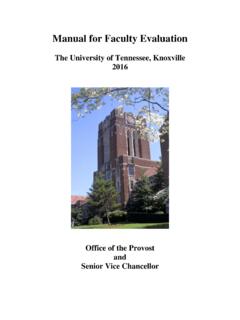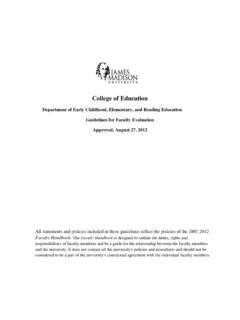Transcription of 03.FAC.05 FACULTY ANNUAL EVALUATION - cob.tamucc.edu
1 FACULTY ANNUAL EVALUATION . (Approved by COB FACULTY on April 22, 2016). (Section A. Amended by email Approval of COB FACULTY October 4, 2016). (Draft February 9, 2018). (Revised and Approved by COB FACULTY March 9, 2018). A. OVERALL ANNUAL EVALUATION . This document outlines the process for evaluating full time FACULTY in the College of Business. The ANNUAL EVALUATION of FACULTY is based on a calendar year. In general, FACULTY are evaluated on scholarly and creative activity, teaching and service performance. The College weights each criterion to reflect the performance expectations for different classifications of FACULTY .
2 Tenured and Tenure-track FACULTY are typically assigned weights to each area of EVALUATION as follows: Tenured FACULTY : 40% scholarly and creative activity, 40% teaching, 20% service. Tenure-track FACULTY : 45% scholarly and creative activity, 45% teaching, 10% service. Weights for tenured FACULTY may be modified by the Dean and/or Department Chair to reflect different performance expectations associated with FACULTY development leave, administrative duties, and other forms of leave/reassignment. Weights for other FACULTY classifications ( , professional assistant professor) are determined in consultation with the Dean and/or Department Chair.
3 FACULTY evaluations are based solely on activities documented in the FACULTY activity database ( , Digital Measures). FACULTY are responsible for documenting scholarly and creative activity, teaching, and service activities. FACULTY are also responsible for providing the following information in the activity database prior to the ANNUAL EVALUATION interview: Completing the ANNUAL Report (under Goals & Accomplishments in Digital Measures). for the EVALUATION period to summarize accomplishments in scholarly and creative activity, teaching, and service activities. Completing and attaching a self- EVALUATION document to the ANNUAL Report (under Goals & Accomplishments in Digital Measures) for the EVALUATION period that specifies the ratings for scholarly and creative activity, EVALUATION , and service (form to be provided).
4 Creating an ANNUAL Report (under Goals & Accomplishments in Digital Measures) for next EVALUATION period to specify scholarly and creative activity, teaching and service goals/objectives. Once appropriate weightings on individual components have been assigned, the weighted total EVALUATION scores are translated into an overall ANNUAL EVALUATION outcome according to the following table: 1. Weighted total score Overall ANNUAL EVALUATION Unsatisfactory Standard High 4 Excellent As stated in University Procedure : Performance Reviews of Full-Time FACULTY Members, merit eligibility requires (1) an above standard overall rating and (2) standard or better ratings in at least 2 EVALUATION areas (which add up to at least a weighting in the overall FACULTY EVALUATION ).
5 2. B. SCHOLARLY AND CREATIVE ACTIVITY EVALUATION . RATING SCALE 1-4. The primary objective of the Scholarly and Creative activity EVALUATION is to encourage FACULTY to contribute to the goals of the College of Business and maintain appropriate AACSB academic qualification status. The primary responsibility of maintaining appropriate status lies with the FACULTY . Scholarly and Creative activity performance of FACULTY is viewed from a long term perspective. Any other circumstance not covered by the present document will be analyzed first by the FACULTY member's direct supervisor. If no agreement can be reached, then if deemed appropriate, the chair of the FQC can be invited to participate in the process.
6 If no agreement is reached between the parties, the final decision will be made by the Dean. B1 AACSB Classification Maintained Through Scholarly Activities (SA/SP). Scholarly activity EVALUATION will be according to the guidelines and list of journals adopted by the FACULTY Qualifications Committee (FQC). Typically, this will include the list developed by the Australian Business Deans Council (ABDC), list of the Association of Business Schools (ABS) commonly known as the International Guide to Academic Journal Quality list, and any other list provided by FQC. This is summarized below in Table B-1. Table B-1. Quality Rating Criteria Points assigned Elite (E) Journal rating of A* by the FACULTY Qualification 30.
7 Committee (FQC). Very High Journal rating of A by the FACULTY Qualification 25. Quality (VHQ) Committee (FQC). High Quality Journal rating of B by the FACULTY Qualification 20. (HQ) Committee (FQC). Quality (Q) Journal rating of C by the FACULTY Qualification 15. Committee (FQC). Other Scholarly book or monograph published by a leading 16-25. intellectual internationally recognized publisher, as agreed upon contributions A in consultation with the Department Chair. (OIC-A). Other Conference presentations or proceedings at 1-15. intellectual international, national or regional levels. Other contributions B output, including anthologies, book chapters, trade (OIC-B) publications, magazine and newspaper articles, etc.
8 As detailed in Table 1 in the document FACULTY Qualifications and Engagement Standards in consultation with the Department Chair Supervisor's EVALUATION of Work in Progress: FACULTY should provide evidence of work under review to their supervisor. Total points for work in progress will range from 0 to 5 points. 3. Rating for ANNUAL EVALUATION Scholarly activity rating would be based on -most recent 3-year total points according to the following table: 3-Year Total Scholarly Activity Score Scholarly COB Performance Activity Category Rating At least 30 total points: must include at least one HQ or Excellent better publication*.
9 At least 22 total points: must include at least one Q or High better publication*. At least 15 total points: must include at least one Q or Standard better publication*. Below 15 total points recognizing that scholarly activities Unsatisfactory are in progress * To receive a Scholarly Activity Rating of or above, a FACULTY member must maintain AACSB. Academic Qualification status (as Scholarly Academic (SA) or Scholarly Practitioner (SP)). New FACULTY : For ANNUAL EVALUATION purposes, newly hired FACULTY members will receive a minimum of (Standard). for their first year. The Scholarly Activity performance for the second year will be evaluated by the direct supervisor.
10 Articles Accepted for Publication: Articles accepted for publication can be used, at FACULTY request, on the year the acceptance letter is received; however, those articles will only be considered for ANNUAL evaluations for a total of three years. Change of Ratings: Journal lists are updated from time to time. EVALUATION will be made using the journal ranking at the time of publication/acceptance. Other Circumstances: The chair of the department, in consultation with the FACULTY member, will determine the quality rating of any books or scholarly activity reports that will substitute for a journal publication in accordance with the FACULTY Qualifications and Engagement Standards document.









